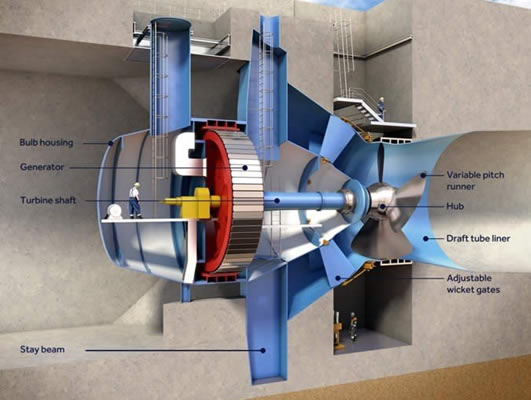The Technology
Tidal Range schemes generate electrical energy by using the difference in water level between the sea and an enclosure – the potential energy – to drive large turbines, similar to the turbines used in some low head hydropower schemes on rivers. Note that this is a different technology to Tidal Stream which uses the speed of the water – the kinetic energy – in fast flowing tidal locations. The ideal locations for Tidal Stream tend to be deep fast flowing water in narrow zones between islands and around headlands and thus are not generally in conflict with preferred Tidal Range locations.
Tidal Range schemes can be designed to generate on both ebb (falling) and flood (rising) tides. They can also be designed to use the generators as pumps to raise or to lower the water levels inside the enclosure, which increases the water head for the following generation stage. This is beneficial because the water is pumped up through a small head but then used to generate through a very much larger head.
The majority of tidal range installations have used “bulb” turbines in which the electrical generator is enclosed within a steel bulb – see below. The La Rance scheme was the first to use turbines that could generate on both ebb and flood tides and also pump.
The latest designs of turbines include the options of variable speed generators and 3 bladed turbines, which are expected to be more fish friendly.
Tidal Lagoons
The Tidal Range schemes constructed to date, such as La Rance in France, have generally consisted of a barrage across a river; often referred to as Tidal Power Barrages. A Tidal Lagoon is the name given to an enclosure that does not include an estuary or large river. This has the benefit that the environmental effects of the scheme tend to be less significant; in particular fish are much less likely to pass through the turbines.
